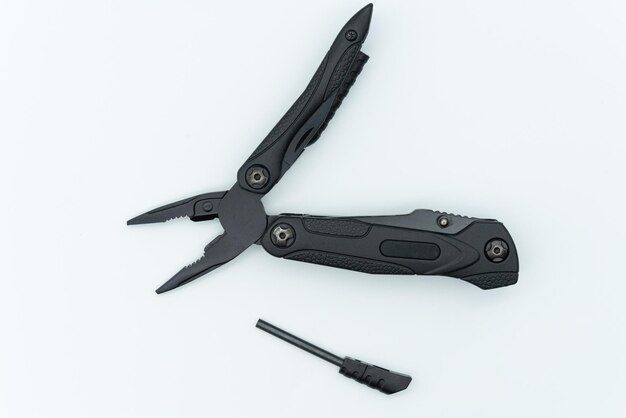Multi-tools are handy gadgets that combine several tools into one compact device. They typically include a knife blade, pliers, screwdrivers, bottle openers, and other tools. But when it comes to cutting, how deep can you actually cut with a multi-tool knife?
Page Contents
What is a multi-tool?
A multi-tool is a handheld device that combines several tools into one compact body. The most common tools included are:
- Knife blade
- Pliers
- Screwdrivers
- Bottle/can opener
- Scissors
- File
- Saw
- Awl
Multi-tools are designed to be portable and convenient. They allow you to carry a variety of basic tools in your pocket or bag, ready for use anytime. This makes them popular among camping enthusiasts, electricians, handymen, and others who need access to tools on-the-go.
Factors affecting cutting depth
When using the knife blade on a multi-tool, there are several factors that determine how deep you can cut:
Blade length
Longer blades can cut deeper than shorter blades. Multi-tool knife blades are typically 1.5 to 3 inches long when fully extended. Smaller multi-tools have shorter knife blades around 1 to 1.5 inches.
Blade thickness
Thicker knife blades are stronger and can cut deeper than thinner blades before flexing. Multi-tool knives are usually moderately thick, in the range of 1.2 to 2.5mm.
Blade design
The shape and style of the knife impacts its cutting ability. Pointed tips can pierce deeper than blunt tips. Serrated sections cut through fibrous materials better. Plain or combination edges affect cutting depth and control.
Blade material
Harder blade materials like high carbon steel hold an edge better for deeper cuts. Softer stainless steel is more resistant to corrosion but cannot cut as deeply before dulling.
Locking mechanism
A locking blade that stays rigidly extended can cut deeper than a folding blade that has some side-to-side wiggle room.
Force applied
The amount of force you exert when cutting also determines how deep the blade penetrates. More downwards pressure allows a deeper cut.
Cutting depth examples
To give an idea of real-world cutting depths for multi-tool knives, here are some examples:
| Multi-tool model | Knife blade length | Maximum cutting depth |
|---|---|---|
| Victorinox SwissTool | 2.5 inches | 1 inch in wood |
| Leatherman Rebar | 2.9 inches | 1.5 inches in wood |
| Gerber Dime | 1.25 inches | 0.5 inch in wood |
| Leatherman Micra | 1.6 inches | 0.75 inch in wood |
These examples demonstrate that typical multi-tool knife blades can cut up to around 1.5 inches deep in wood when a firm downward force is applied. Smaller blades under 2 inches are limited to less than an inch depth. The knives are capable of moderately deep cuts, but not as deep as larger pocket or fixed blade knives.
Cutting techniques
Using proper technique will allow you to cut deeper with a multi-tool knife than poor technique. Follow these tips:
- Extend the knife fully and engage any locking mechanism so it is rigid.
- Place one hand on the handle with your thumb pressed against the spine of the blade for control.
- With your other hand, press straight down on the rear of the blade to apply force as you cut.
- Use the wrist and elbow of your guiding hand to control blade motion, avoiding bending or twisting.
- Keep the blade perpendicular to the material without angling for cleaner cuts.
- Use the sweet spot of the blade, around 1/3 from the handle.
- Make shallower passes rather than trying to cut through in one pass.
- Let the blade do the work rather than using brute muscle force.
Maintenance for deeper cutting
Properly maintaining your multi-tool knife will keep the blade sharp and allow deeper cutting over time. Recommended maintenance includes:
- Wiping down the blade to keep it clean and free of debris.
- Applying lubricating oil to prevent corrosion.
- Sharpening on a whetstone or with a sharpening system periodically.
- Checking for damage like chips and cracks in the blade.
- Tightening any loose screws to keep the knife securely extended.
Cutting limitations
While multi-tool knife blades can cut moderately deep, they do have some limitations:
- The short blade length prevents very deep cuts.
- The blade thickness leads to some flexibility under pressure.
- The steel hardness and locking mechanisms are decent but not top-tier.
- The mixed tool design requires compromise on ergonomics.
For these reasons, a dedicated fixed blade or pocket knife are better choices when you need to make very deep cuts. Multi-tools are designed for moderate convenience rather than specialized tasks.
Uses within cutting depth limits
Some good uses that match the cutting depth abilities of multi-tools include:
- Food preparation – slicing fruit and vegetables, trimming meat.
- Opening packaging on boxes and plastic items.
- Outdoor tasks like sharpening sticks for marshmallows or cutting cord and fishing line.
- Camping chores like cutting small branches and shaving tinder for fires.
- DIY activities like cutting drywall or thin wood/plastic.
For heavy duty cutting tasks, choose a tool designed specifically for that purpose. But for general everyday cutting, a multi-tool knife can perform quite well.
Conclusion
Multi-tool knife blades can cut to a depth of around 1-1.5 inches in wood when properly used. The exact cutting depth depends on the blade length, thickness, design, material, and locking mechanism. Proper cutting technique and blade maintenance also improve cutting ability. While multi-tool knives are limited compared to larger blades, they can still cut moderately deep for utility purposes. When used within their limits, they are versatile and convenient cutting tools for everyday carry.
